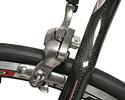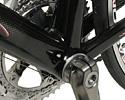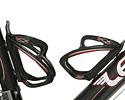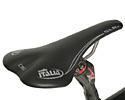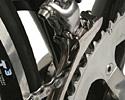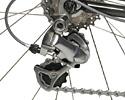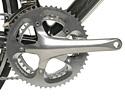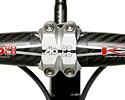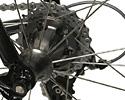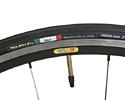
Recently on Cyclingnews.com |
On test: Leggera Piuma, August 16, 2006
Light & stiff for the open road
Australia's Leggera tops its range with this appropriately-named carbon fiber featherweight and delivers it with a refreshing dose of realism about carbon fiber manufacture, as John Kenny discovered.
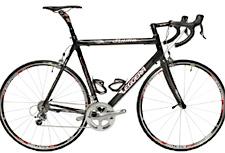
|
Leggera is a small but expanding brand based on Australia's Gold Coast. A recent merger with internationally renowned Australian builder, Peter Teschner, has added some experience and variety to its line up. It's seems like a workable marriage; Leggera can now accommodate customers who demand off-the-peg carbon fibre frames and also provide bespoke rigs through Teschner.
The Piuma (Italian for 'feather') carbon monocoque is the top-of-the-line offering from the company. At less than one kilo for the frame it's appropriately named. With a complete bike weight of 7.3 kilograms (without pedals) and a price tag of around seven-and-a-half thousand Aussie dollars, the Piuma is competitive with other carbon Dura-Ace equipped bikes on the market.
Laboratory testing
Piumas have undergone some intensive testing by a leading German bike publication. The magazine performs some of the most stringent and technically demanding tests on bike frames according to Paul Farrell, President of Teschner-Leggera International. "Bikes are physically dismantled and the frames are subjected to a barrage of tests by an independent laboratory," he said. "Each frame is weighed accurately and is then [tested] to measure frame flex at the bottom bracket and head tube. [The laboratory] uses a formula that combines the frame weight with various measured stiffness factors to come up with an overall score."
The Piuma performed extremely well in these tests, says Farrell. "We can claim that the Piuma SL and the standard Piuma were ranked numbers one and three out the most recent list of 171."
The oversized tubes of the ultra-light tubes help achieve the stiffness. They're bulky enough to provide the optical illusion of cumbersomeness, but this false impression is dispelled when you pick the bike up. The strength of the frame has been achieved through this larger than average tubing (not by special profiling or shaping of the tubes) although the downside of having such a chunky top tube was a tendency for me to knock the top tube with my pronating knee when I was riding out of the saddle.
Applying the basics
Leggera has avoided the usual techno-jargon in describing its manufacturing processes, despite the fact that there are undoubtedly some innovations that could have been advocated by Leggera. "Some companies claim to have discovered some 'top-secret' process or a 'new' carbon technology that no-one else can get. It's all complete rubbish. Approximately 90 per cent of ALL hi-end carbon frames come out of the same very few factories and with little exception they all use the same carbons and processes," said Farrell with refreshing candour.
Statements like that could put people like me out of business. "People! They're all the same bike with different stickers!" Thankfully Farrell gave me an angle to work with as he said that Leggera puts its efforts into the initial design and lay-up of their frames and choose more exotic (and expensive) carbon blends. It's all about the basics: design, choice of materials, attention to detail and piles of real-world testing.
Ride quality
The Piuma has a relaxed seat tube on the 60-centimetre (centre to top) model tested and at 72°, is one degree slacker than I am used to. I had to move the seat forward considerably to avoid sitting too far behind the bottom bracket. The seat angles in the range tend to be on the relaxed side (the four size options that are 56 centimetres and above are all 72.5 degrees and slacker). A big gear masher who likes to sit right behind the bottom bracket might enjoy the extra layback.
The angles are designed to enhance the road-racing experience. I survive mostly on a diet of criteriums and the handling that results from the shallow angles and shorter top tube didn't really suit that application. However, for riders who ride long road races and like to sit over the bottom bracket, the geometry is ideal. Master builder Peter Teschner had this to say: "The Piuma has unashamedly been designed to reflect a full race-bred bike following in the same [foot] print as numerous high-end European designs… there is a tendency for marginally shorter top tubes and slightly shallower seat tube angles in the pro peloton."
The shortness of the top tube did not suit me as I have a disproportionately long torso. The long stem provided on the test bike compensated for this but I found that this negatively affected the handling and weight distribution around the bike. The Piuma provided a fantastic ride on long stretches of road, but I struggled to get the bike around tight corners at speed. I quickly learned not to push the handling limits of the bike on hairpin bends for fear of meeting an undignified end. I acknowledge, however, that my body shape leans toward the atypical and undoubtedly affected aspects of the ride.
A quick look around a few pro bikes reveals that top tube lengths actually vary widely, much as you would expect. However, I have noticed relatively short top tubes on a number of Italian bikes.
The lightness of the Piuma was really noticeable when climbing, where the bike felt agile and responsive. The frame is taut when climbing out of the saddle and when sprinting, but the comfort of the frame provides the most enviable aspect of the ride. Providing evidence of the plushness of the ride is the fact that this is the first time that I have left a Selle Italia SLR saddle on a test bike for more than one ride. This saddle is not normally suited to my anatomy and pain threshold, but it actually felt comfortable on the Piuma.
The frame felt stiff, but I'd be reluctant to say that the Piuma provided the stiffest ride of any monocoque frame that I have ridden. It goes to show that there remains a crucial difference between subjective and objective testing and I would have happily sacrificed a small amount of the frame's comfort for even more stiffness, the Piuma's ranking in the Tour publication notwithstanding.
Appearance
There's plenty to like about the Piuma's appearance: the raw black carbon tubes, the quality and thickness of the clear coat, the understated livery and the matching carbon accoutrements (stem, 'bars and seat post). It's a very fetching looking bike without being a show pony. The finish, a high gloss carbon weave, looks great with the Piuma artwork.
Warranty
In addition to the pleasing appearance, insubstantial weight and pleasant ride quality, Leggera offers a lifetime warranty on the frame and forks. Thankfully there is no escape clause to sully the warranty if the bike is raced. This should help to assuage any fears about after-sales service in the event of frame failure.
Wheels
The Easton Ascent II wheels underline the overall quality of the package. Their ultra light weight (1420 grams) belies their stiffness and strength. The elliptical spokes on these hand-built wheels are laced nice and taut to increase strength. Easton uses "Twin Thread" technology to achieve the extra tension. The spokes are not only threaded at the rim, but at the hub as well. There are no elbows on the spokes to weaken them. The rear rim is also offset to counter the dish required for the cassette, so the spokes on the rear have more equal tension from the drive to non-drive side. With the silky-smooth bearings in the hub and the classic black rims these are an excellent choice for this lightweight bike.
Mechanic's view
Much as I liked the feel and design of the wheels, Bob de Kantzow from Stanmore Cycles in Sydney has encountered some problems with the Easton spoke arrangement, "It may seem like I have a wheel fetish [see de Kantzow's comments in Cylingnews' recent Argon 18 review] but having had experience with broken spokes in these wheels I know that they are difficult and time-consuming to repair," he said.
"[To fix a broken spoke] you have to: remove the broken spoke from the hub and refit it with high-strength Locktite, wait for the Locktite to cure for, say, 24 hours and then fit the rim and true it. If you doubt my concerns, consult the Velomax web site for confirmation," he said.
So, the dual thread design adds an extra fiddly step to any repair as a broken spoke has to be replaced and set at the hub 24 hours before the wheel can be trued and ridden again.
Rest of the bits
The Modolo seat post represents a radical departure from traditional design. It's got a whopping great hole in it near the seat clamp. It's the one aspect of the package that everybody noticed. The quirky design is primarily aimed at improving aerodynamics but there is a claimed increase in strength as well and at 175 grams, it's also very light.
I liked the design for more a more practical reason: the easily adjustable seat clamp. This should be a simple operation for all seat posts, but it's surprising how often seat post manufacturers get this what should be a simple operation wrong.
Modolo's carbon Curvissima handlebars have an ergonomic shape that feels comfortable when riding on the drops as the palm of my hand was in contact with a large surface area of this part of the handlebar. When holding this position when out of the saddle there was no danger of my wrists hitting the top bend of the 'bars. Modolo have come up with an odd way to route the cables, with the brake cable routed to cross the top of the 'bars and meet the gear cable at the back. Thick handlebar tape pads out the brake cable to an extent, but I still felt like the cable was in the wrong spot, right under the palm of my hand. I can't see any real advantage in this aspect of the design. Still, they feel stiff and anatomically fine in most hand positions. At 195 grams they don't add unnecessary weight.
The stem has a much more traditional look about it with a four-bolt headpiece holding the 'bars tightly to the CNC-machined lightweight body of the stem.
Overall
The Piuma has all of the features that I like in a carbon monocoque rig: lightness, rigidity and comfort. The handling was not to my taste, but then the bike is not really aimed at people like me who mostly ride crits and hack about on the weekends. Nevertheless, I think that a significant number of riders enjoy razor sharp handling (even at the expense of straight-line stability) and a closer parity between the top and down tubes.
Teschner and Leggera bikes are aimed at experienced riders and pitch their designs at a customer base that understands the difference between a bike designed purely for road racing and a general-purpose bike. Paul Farrell sums up the design philosophy thus: "This is not a bike to take shopping!"
Price: AU$7500
Weight: 7.3kg (without pedals)
Pros: Light, stiff, excellent fit kit. Designed for dedicated road racing
Cons: Relaxed seat angle and short top tube not to everyone's taste
Cyclingnews rating: ![]()
Photography
For a thumbnail gallery of these images, click here
Images by Paul Henderson-Kelly/Cyclingnews.com
- Leggera Piuma at 7.3kg in a 60cm frame, very much a modern lightweight.
- The seat cluster area
- The carbon weave shows through.
- The bottom bracket area is plenty beefy, with a flared seat tube to provide reinforcement and that huge down tube.
- The cable adjusters are riveted into place. It's not exactly pretty, but it works.
- In case you're wondering the graphic gives a clue - the name means 'feather'
- The head badge.
- Modolo KX bottle cages boost the carbon quota.
- The front end includes Leggera's carbon fork, Modolo bars and stem and Easton front wheel. It all turns in an FSA headset.
- Modolo KX seat post provides a big gap for the air to pass through. It's allegedly more aerodynamic. It's definitely more eye-catching.
- Easy adjustment - precise angle adjustment is a real advantage of the Modolo post.
- Selle Italia SLR saddle - a seat you either love or hate, it seems.
- The transmission - all Dura-Ace, all the time
- The Dura-Ace front derailleur mounts on a clamp-on fitting.
- Shimano Dura-Ace rear derailleur - it works.
- Shimano Dura-Ace chainset is one of the stiffest around, as befits a stiff frame
- Dura-Ace brakes - sure stoppers.
- Modolo bar and stem
- Plenty of adjustment Leggera makes sure you will be able to get the stem height up with a generous supply of spacers.
- The Easton hubs use threaded spokes at both ends, which can make for problems if they need to be repaired.
- Easton Ascent II wheels
- Veloflex Black 'open tubulars' are light and fast-rolling
- The seat clamp - another spot for a logo.
Full specification: |
MSRP: AU$7,500 |
||
|
|
|||
|
Frame |
UDPP carbon fiber monocoque |
Wheels |
Easton Ascent II |
|
Fork |
Carbon fiber |
Tyres |
Veloflex Black |
|
Colour |
High gloss carbon |
|
|
|
|
Stem |
Modolo Xtra aluminium |
|
Sizes |
50, 52, 54, 56, 58, 60 (tested), 62cm |
Handlebars |
Modolo KX carbon fiber |
|
Seat angle |
72° (on test bike - varies from 74° on 50cm) |
Headset |
FSA integrated |
|
Crankset |
Shimano Dura-Ace |
Tape |
Leggera |
|
Chainrings |
Shimano Dura-Ace 53/39 |
|
|
|
Bottom bracket |
Shimano Dura-Ace |
Pedals |
NA |
|
Front derailleur |
Shimano Dura-Ace braze-on with clamp |
Saddle |
SelleItalia SLR XP |
|
Rear derailleur |
Shimano Dura-Ace |
Seatpost |
Modolo KX carbon fiber |
|
Sprockets |
Shimano Dura-Ace |
Extras |
Modolo KX carbon fiber bottle cages |
|
Chain |
Shimano Dura-Ace |
|
|
|
|
|
More information |
|
|
Brakes |
Shimano Dura-Ace |
|
|
|
Brake levers |
Shimano Dura-Ace |
|
|


